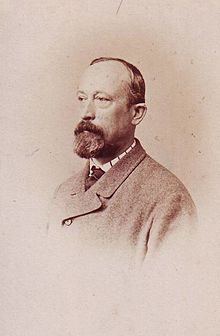Friedrich Immisch
Friedrich Immisch (born April 27, 1826 in Zwickau , † February 22, 1892 in Heidelberg ) was a famous drum doctor.
Life
Friedrich Immisch began studying medicine at the University of Jena in the mid-1840s . During this time, he was a senior medical student Paukarzt the Corps Guestphalia Jena . He himself was not active, but carried a pistol gauge on the colors of the Guestphalia. In 1849 the band of Guestphalia was dedicated to him. Still in Jena, after a scale accident, he experimented with the construction of iron goggles to protect the eyes on the scale, which, however, was not yet fully accepted there.
To continue his studies and to prepare for the exam, he moved to the Ruprecht-Karls-Universität Heidelberg in 1849 . The Heidelberg Senior Citizens' Convention was looking for a new drum doctor and so Immisch was also employed here. He finished his medical studies without a degree or doctorate. For 36 years he looked after the five corps and two fraternities of Heidelberg with a total of over 12,000 lengths. He is said to have set over 30,000 needles. It must be taken into account that he developed wound care methods that managed entirely or partially without the need for needle sticks. So he tied threads to the hair near the wound and knotted them so that he could pull the wound together. Sometimes he knotted the hair directly. This had the advantage that the wound secretion could flow away better, which was an advantage given the antisepsis and asepsis status at the time . In Heidelberg he also continued his experiments with the timpani, which then prevailed throughout the German-speaking area by the mid-1850s.
Immisch married Klara Ditteney in 1864, the daughter of the owner of the restaurant “in der Hirschgasse ”, where the Heidelberg connections took place for many decades until well into the 20th century.
The American writer and satirist Mark Twain visited Heidelberg for several months in the summer of 1878, frequented the local corps there and also took part in a school day , which he detailed in his work A Tramp Abroad (German "Stroll through Europe", original edition London 1880 ) described. Here he also mentioned the gray-haired surgeon ("gray-haired surgeon"), who examined the injured tympanic edges with a sponge and then provided medical care. His illustrator Walter Francis Brown made the portrait The Old Surgeon ("The old surgeon") as an illustration for the book.
As a practitioner of the old school, Immisch enjoyed a high reputation among the fraternity students in Heidelberg. There was no contradiction to his word. However, his practical experience resulted in a certain rejection of new knowledge and procedures, especially in the area of avoiding wound infections, which at that time represented a great danger for the fencer. When, in the winter semester of 1884/85, all of the pommels he cared for fell ill with sore throat , confidence in the great practitioner was gone and the corps retired him a year later. A few semesters later he also resigned from the fraternities.
The Corps campaigned for Friedrich Immisch to receive the title of “Dr.” on the occasion of the 500th anniversary of Heidelberg University in 1886 because of his services. med. ”was awarded. He received an annual pension from the corps and fraternities in Heidelberg. He died of a stroke at the age of 65 . All the corporations he looked after attended his funeral with official delegations. Friedrich Immisch is still the most famous drum doctor to this day.
Works
- About the "drumming" and the disturbances that occur during the treatment of the "throws" and that hinder the rapid healing of the wounds . Heidelberg 1885.
literature
- Immisch and the goggles . Korpszeitung der Jenenser Westfalen No. 18 (December 1929), pp. 1–2.
- Geert Seelig : A Heidelberg boy of fifty years. From German students. Schleswig-Holstein lawyers and soldiers in Berlin in the Bismarckian Empire. Memories. Heidelberg 1933.
- Weiland Bursch zu Heidelberg, Festschrift of the Heidelberg Corporations for the 600th anniversary of Ruperto Carola , Heidelberg 1986.
- Peter Hauser : Schmisse, Lappen, Bochensplitter - About the drum doctor system in the 19th and the beginning of the 20th century with special consideration of Heidelberg . Once and now, yearbook of the Association for Corpsstudentische Geschichtsforschung eV, Volume 50, Neustadt an der Aisch 2005.
Web links
Individual evidence
- ↑ Kösener Corpslisten 1930, 75/97
| personal data | |
|---|---|
| SURNAME | Immisch, Friedrich |
| BRIEF DESCRIPTION | Timpanist, inventor of the timpani |
| DATE OF BIRTH | April 27, 1826 |
| PLACE OF BIRTH | Zwickau |
| DATE OF DEATH | February 22, 1892 |
| Place of death | Heidelberg |


